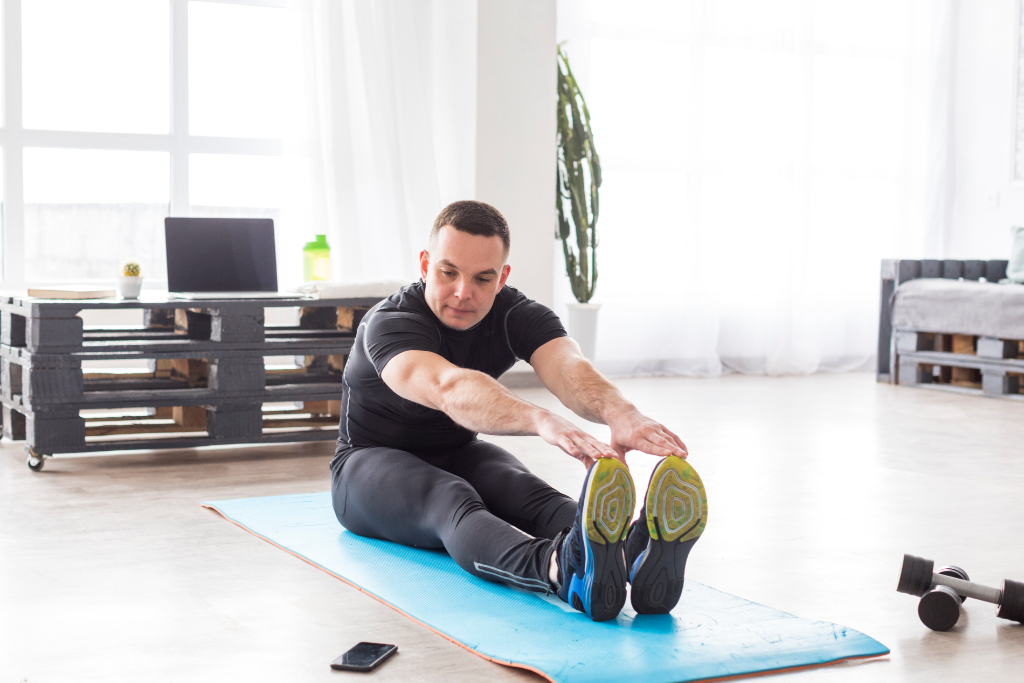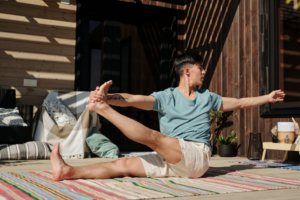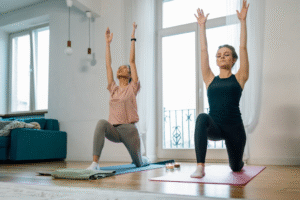All-body workouts are a convenient and effective way to get a full-body workout at home without the need for a gym membership or expensive equipment.
These workouts are perfect for people of all fitness levels, providing a comprehensive routine that targets every major muscle group.
Whether your goal is to build strength, boost endurance, or enhance flexibility, all body workouts can help you achieve it.
What makes all physical exercises appealing is their flexibility and versatility.
With only body weight, you can do exercises that engage the legs, muscles, and upper body at the same time.
This makes them perfect for routines at home where space and equipment can be limited.
Plus, it requires little to no preparation, which means you can get started right away.
In this guide, we’ll explore some of the best full-body workouts you can do at home, offer tips on setting up your routine, and share ways to get the most out of Whether you are a beginner or a fitness enthusiast, this workout will help you achieve a balanced full body workout in no time.
Table of Contents
What Are All Body Workouts?
Whole-body workouts, commonly referred to as full-body workouts, are exercises that target multiple muscle groups at one time. This workout is designed to engage your whole body, giving you a balanced approach to strength, endurance, and overall fitness. Unlike isolated exercises that focus on one muscle group whole-body exercises incorporate compound movements that activate multiple muscle groups at the same time
Benefits of All Body Workouts
Time Efficiency: By working your entire body in one session, you can maximize your results without spending hours in the gym.
Improved Strength: All body workouts help to build strength across all major muscle groups, promoting muscle growth and functional fitness.
Better Cardiovascular Health: Many full-body exercises, such as squats and burpees, increase heart rate, improving cardiovascular endurance.
Calorie Burning: These workouts tend to burn more calories because they engage multiple muscles and can be performed at a higher intensity.
Increased Flexibility and Mobility: By incorporating a wide variety of movements, all body workouts help to improve joint flexibility and mobility.
Convenience: Full-body exercises require minimal equipment, making them ideal for home workouts or on-the-go training.
Common Exercises in All Body Workouts
Squats: A foundational lower-body exercise that targets the quadriceps, hamstrings, and glutes. Squats also engage your core, making it a full-body movement.
Push-ups: Excellent for building upper body strength, push-ups work the chest, shoulders, triceps, and core.
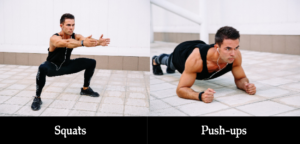
Lunges: Another great lower-body exercise, lunges target the legs and glutes, while also helping with balance and coordination.
Deadlifts: A compound exercise that strengthens the back, legs, and core. Deadlifts are one of the most effective all-body workouts.

Planks: This core-focused exercise also works the shoulders, back, and glutes. It’s a great way to improve stability and posture.
Burpees: A high-intensity exercise that combines a squat, push-up, and jump, burpees engage almost every muscle group and are perfect for improving cardiovascular endurance.

How to Structure an All-Body Workout Routine
- When planning an all-body workout, aim to include exercises that target the following major muscle groups:
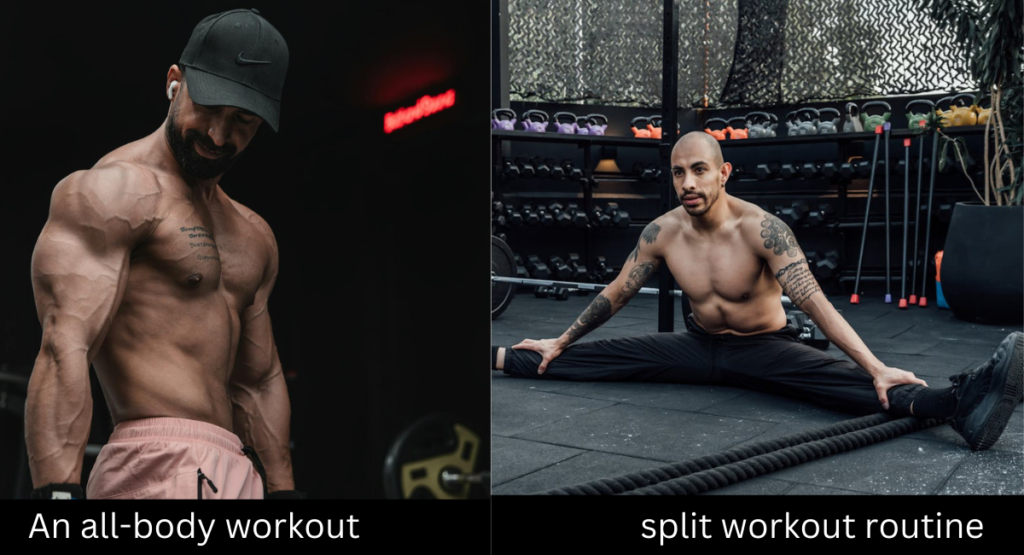
- Upper Body: Chest, shoulders, back, arms
- Lower Body: Quads, hamstrings, glutes, calves
- Core: Abs, obliques, lower back
For beginners, a simple full-body workout can consist of 3-4 sets of 8-12 reps for each exercise. As you progress, you can increase intensity, volume, or the number of exercises.
Sample All Body Workout
Here’s an example of a beginner-friendly all-body workout routine:
- Squats – 3 sets of 10-12 reps
- Push-ups – 3 sets of 8-10 reps
- Lunges – 3 sets of 10 reps per leg
- Planks – 3 sets of 30-45 seconds
- Burpees – 3 sets of 8-10 reps
All-body workouts are an excellent choice for anyone looking to improve their overall fitness. They are efficient, and effective, and can be easily modified to suit all fitness levels. By incorporating these full-body exercises into your routine, you can achieve better strength, endurance, and flexibility while saving time in your busy schedule.
Benefits of All Body Workouts
All-body exercises offer a wide range of benefits, making them ideal for individuals looking to improve overall fitness. These full-body activities engage multiple muscle groups, improving strength, improving cardiovascular health, and burning calories more efficiently than isolated exercise Below we explore the key benefits it’s on a whole-body workout.
1. Time Efficiency
One of the biggest advantages of all body workouts is that they save time. By targeting multiple muscle groups in a single session, you can achieve a full-body workout in less time compared to split training routines that focus on one muscle group at a time. This makes all-body workouts perfect for those with busy schedules, allowing you to maximize results in a shorter workout window.
2. Improved Strength
All body workouts are designed to strengthen various muscle groups simultaneously. By engaging both the upper and lower body in one routine, you can develop more balanced strength. Compound movements like squats, push-ups, and deadlifts are particularly effective at building muscle mass, improving functional strength, and boosting overall performance in everyday activities.
3. Better Cardiovascular Health
Full-body exercises, especially high-intensity movements like burpees and mountain climbers, increase heart rate and improve cardiovascular endurance. Engaging multiple muscle groups at once requires more energy, which challenges the heart and lungs, helping to boost cardiovascular health over time. Including aerobic exercises in all body workouts can help improve endurance and stamina.
4. Calorie Burning and Weight Loss
Because all body workouts engage larger muscle groups and are often performed at higher intensities, they burn more calories compared to isolated exercises. This can lead to more significant weight loss results, especially when combined with a balanced diet. High-intensity full-body exercises, such as burpees and kettlebell swings, not only burn calories during the workout but also promote post-exercise calorie burn (known as excess post-exercise oxygen consumption or EPOC).
5. Increased Flexibility and Mobility
Many all-body workouts incorporate functional movements that promote joint mobility and flexibility. Exercises like lunges, squats, and deadlifts help improve the range of motion in the hips, knees, and shoulders, which is essential for preventing injuries. Incorporating dynamic stretches and full-body movements into your routine can also enhance flexibility over time.
6. Enhanced Core Stability
Core strength is essential for overall fitness, and all physical exercises are naturally involved in almost every exercise. Movements such as squats, push-ups, planks, and deadlifts work the muscles in the abdomen, bac,k, and hips. A strong core improves posture, stability, ty, and balance, making daily tasks easier and reducing the risk of injury.
7. Better Functional Fitness
All body workouts improve functional fitness, which refers to the ability to perform everyday tasks more effectively. By mimicking natural body movements (e.g., squatting, lifting, pushing), these workouts help improve your strength, coordination, and endurance for real-life activities such as carrying groceries, climbing stairs, or lifting objects. Functional training enhances your body’s ability to move efficiently in various situations.
8. Convenience
All body workouts can be done with minimal equipment, or even with no equipment at all. Bodyweight exercises like squats, lunges, push-ups, and planks require nothing more than your own body. This makall-bodyody workout is incredibly convenient for home workouts or those on the go. You can do these exercises in a small space without needing access to a gym or specialized gear.
9. Improved Mental Health
Exercise, including all body workouts, is known to release endorphins, the “feel-good” hormones that can boost mood and reduce stress. The physical challenge of performing full-body exercises can also help increase mental toughness and improve focus. Over time, as you see progress in strength, endurance, and overall fitness, it can positively affect your confidence and self-esteem.
10. Variety and Fun
All body workouts are highly versatile, allowing for a variety of exercises that can keep your routine fresh and exciting. You can switch between strength-based exercises, high-intensity interval training (HIIT), and mobility-focused movements to keep your workouts interesting. This variety helps to prevent workout boredom and keeps you motivated to stick with your fitness routine.
Incorporating all body workouts into your fitness routine is an effective and efficient way to achieve overall health and fitness goals. From time-saving benefits to improved strength, cardiovascular health, and flexibility, full-body exercises offer comprehensive results. Whether you’re looking to lose weight, increase strength, or enhance mobility, all body workouts can help you reach your goals while keeping things fresh and convenient.
Best All-Body Workouts for Home
All body workouts are perfect for home fitness routines as they require minimal equipment and can effectively target multiple muscle groups at once. Whether you’re a beginner or an experienced athlete, there are several exercises you can do in the comfort of your own home to achieve a full-body workout. Below are some of the best all-body workouts for home, along with instructions on how to perform each movement.
1. Bodyweight Squats
Benefits: Squats are a fundamental lower-body exercise that targets the quads, hamstrings, glutes, and core. They also help with balance and flexibility.
How to Perform:
- Stand with your feet shoulder-width apart.
- Lower your body by bending your knees and pushing your hips back, as if you’re sitting in a chair.
- Keep your back straight and your chest lifted.
- Lower down until your thighs are parallel to the floor, then push through your heels to return to standing.
- Perform 3 sets of 12-15 reps.
2. Push-ups
Benefits: Push-ups are a great exercise to build upper body strength, especially for the chest, shoulders, triceps, and core.
How to Perform:
- Start in a plank position with your hands slightly wider than shoulder-width apart.
- Lower your body by bending your elbows until your chest nearly touches the floor.
- Push through your palms to lift your body back to the starting position.
- Modify by performing knee push-ups if needed.
- Perform 3 sets of 8-12 reps.
3. Lunges
Benefits: Lunges are a powerful lower-body exercise that works the legs, glutes, and core while improving balance and stability.
How to Perform:
- Stand tall with your feet together.
- Step forward with one leg, lowering your hips until both knees are bent at 90-degree angles.
- Push through the front heel to return to standing.
- Alternate legs and repeat.
- Perform 3 sets of 12-15 reps per leg.
4. Planks
Benefits: Planks are excellent for strengthening the core, but they also engage the shoulders, back, and glutes.
How to Perform:
- Start in a forearm plank position with your elbows directly under your shoulders and your body in a straight line.
- Keep your core tight, and hips level, and avoid letting your back sag.
- Hold the position for 30-45 seconds, or as long as you can maintain proper form.
- Perform 3 sets.
5. Burpees
Benefits: Burpees are a full-body exercise that works for for almost every muscle group while also improving cardiovascular health and burning calories.
How to Perform:
- Start by standing with your feet shoulder-width apart.
- Drop into a squat position and place your hands on the floor.
- Jump your feet back to a plank position, perform a push-up, then jump your feet forward again.
- Explode upward into a jump and clap your hands overhead.
- Perform 3 sets of 8-12 reps.
6. Mountain Climbers
Benefits: Mountain climbers are a high-intensity exercise that targets the core, shoulders, arms, and legs whilee boosting cardiovascular endurance.
How to Perform:
- Start in a plank position with your hands under your shoulders and your body in a straight line.
- Quickly bring one knee toward your chest, then switch legs in a running motion.
- Keep your core tight and move as fast as you can without compromising form.
- Perform 3 sets of 20-30 seconds.
7. Glute Bridges
Benefits: Glute bridges focus on the glutes, hamstrings, and lower back, helping to improve hip mobility and lower body strength.
How to Perform:
- Lie on your back with your knees bent and feet flat on the floor, hip-width apart.
- Press through your heels and lift your hips towards the ceiling, squeezing your glutes at the top.
- Lower back down slowly and repeat.
- Perform 3 sets of 12-15 reps.
8. Jumping Jacks
Benefits: Jumping jacks are a simple yet effective cardiovascular exercise that works the whole body, improving coordination and endurance.
How to Perform:
- Stand with your feet together and arms at your sides.
- Jump your feet out wide while raising your arms overhead.
- Jump back to the starting position.
- Perform 3 sets of 30 seconds.
All body workouts are ideal for home fitness routines as they require minimal to no equipment and can effectively target multiple muscle groups immediately.
Whether you’re using bobodyweightercises like squats and push-ups, or more dynamic moves like jumps and mountain climbers, these workouts will help you build strength, endurance, and flexibility.
Incorporate these exercises into your routine for a comprehensive and effective full-body workout at home.
How to Structure Your All All-Bodykout Routine
When it comes to fitness, an effective workout routine is key to achieving your goals. All-body workouts are a fantastic way to target multiple muscle groups simultaneously, improving strength, endurance, and overall fitness. Structuring your all-body workout routine effectively can help you maximize your results while preventing overtraining and ensuring you stay motivated. Below, we’ll discuss how to structure your all-body workout routine for optimal results.
1. Warm-Up First
Before diving into your all-body workout, it’s essential to prepare your body with a proper warm-up. A warm-up helps increase blood flow to your muscles, improving flexibility and reducing the risk of injury. Aim for 5-10 minutes of light cardio (such as jogging in place, jumping jacks, or cycling) followed by dynamic stretches (e.g., leg swings, and arm circles).
2. Select Compound Exercises
When structuring your all-body workout routine, focus on compound exercises that work for multiple muscle groups at once. These exercises are time-efficient and provide a full-body workout, which is perfect for targeting everything in one session. Examples of compound exercises include:
- Squats (targets legs, glutes, and core)
- Push-ups (targets chest, shoulders, triceps, and core)
- Deadlifts (targets back, legs, and core)
- Lunges (targets legs and glutes)
- Burpees (targets multiple muscle groups and improves cardiovascular health)
3. Divide Into Upper and Lower Body Focus
While all body workouts target the whole body, it can be helpful to divide the workout into upper and lower body sections. This ensures you’re giving enough attention to both the upper and lower body while allowing muscle groups to recover. Here’s how you can structure it:
- Upper Body Focus: Perform exercises like push-ups, pull-ups, and shoulder presses.
- Lower Body Focus: Perform exercises like squats, lunges, and glute bridges.
- Full-Body Movements: Incorporate exercises like burpees, deadlifts, and mountain climbers that target both upper and lower body muscles.
4. Balance Strength and Cardio
An effective total body workout should balance strength and cardio workouts. Strength exercises like squats, deadlifts, and push-ups help tone your muscles, while cardio exercises like burpees and climbers raise your heart rate and improve endurance.ce
Alternate between strength-based and cardio-based exercises to structure your routine so that your workouts are engaging. For example, you can do some squats (strength) followed by jumping jacks (cardio), then move on to push-ups (strength) and burpees (cardio).
5. Determine Sets and Reps
How many sets and reps you perform depends on your fitness goals:
- For Strength: Aim for 3-5 sets of 4-8 reps for each exercise.
- For Endurance: Aim for 2-4 sets of 12-15 reps.
- For Cardiovascular Fitness: Do exercises like burpees or mountain climbers for 30-60 seconds per set.
Adjust the number of set reps based on your fitness level and workout intensity. For beginners, it’s usually best to start with 2-3 of each exercise, gradually increasing the number as you build strength and endurance.
6. Incorporate Rest Periods
Rest is just as important as the workout itself, especially when performing all-body workouts. Between sets, take 30-60 seconds of rest to allow your muscles to recover and prepare for the next set. For higher-intensity circuits (such as those involving burpees or mountain climbers), you may want to take shorter rest periods (15-30 seconds) to maintain your heart rate and challenge your cardiovascular system.
7. Cool Down and Stretch
Don’t skip a cold one after a full-body workout. This phase helps your heart rate slowly return to normal and reduces muscle pain. Focus on the muscles worked during the session and do 5-10 minutes of light cardio followed by static stretching.
SampleAll-Bodyy Workout Routine
Here’s an example of a structured all-body workout routine:
- Warm-up: 5-10 minutes of light cardio + dynamic stretches
- Exercise 1: Squats – 3 sets of 12-15 reps
- Exercise 2: Push-ups – 3 sets of 10-12 reps
- Exercise 3: Burpees – 3 sets of 10-12 reps (cardio focus)
- Exercise 4: Lunges – 3 sets of 12 reps per leg
- Exercise 5: Planks – 3 sets of 30-45 seconds
- Cool-down: 5-10 minutes of light cardio + static stretches
Tips for Maximizing Results with All Body Workouts
To get the most out of your all-body workouts, there are several strategies you can use to boost efficiency, effectiveness, and results. Below are some practical tips that can help you maximize your progress.
- Maintain Proper Form: Quality over quantity. Ensure you’re performing each exercise with proper form to prevent injury.
- Increase Intensity: To progress, increase the intensity by adding more reps, and sets, or reducing rest time between exercises.
- Stay Consistent: Aim for at least 3-4 full-body workouts per week for the best results.
- Track Your Progress: Keep track of your reps, sets, and performance over time to stay motivated and monitor improvements.
ConclusioAll-body
All body workouts are an excellent way to improve overall fitness, build strength, and burn fat without requiring a lot of equipment or time.
By targeting multiple muscle groups at once, these workouts provide a time-efficient solution for achieving full body conditioning.
Whether you’re a beginner or an experienced athlete, incorporating all-body workouts into your routine can help you develop a balanced physique, boost cardiovascular health, and enhance flexibility. To get the best results from your all-body workouts, it’s important to stay consistent, focus on proper form, and gradually increase intensity.
By structuring your routine with a combination of strength and cardio exercises, prioritizing recovery, and fueling your body with the right nutrients, you can maximize the benefits of each workout.
With dedication and the right approach, all body workouts can help you achieve your fitness goals and maintain long-term health.

